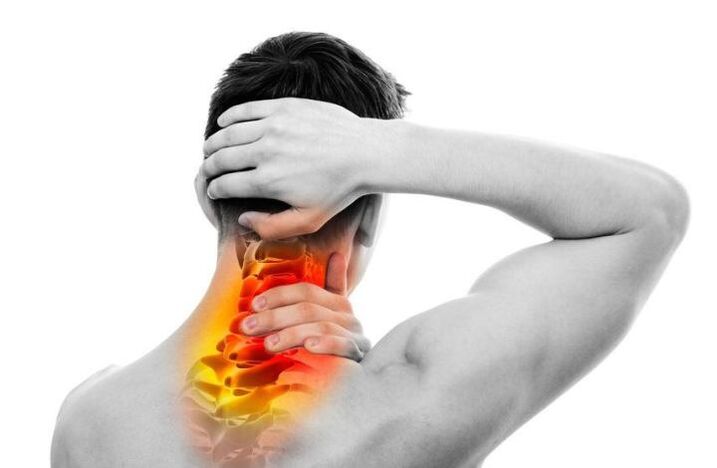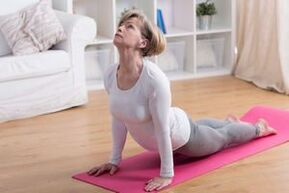Osteochondrosis is a condition in which damage to the vertebrae results in compression of the intervertebral discs. This can cause pain due to compression of nerve fibers. Constricted blood flow leads to destruction of internal organs. When the disease occurs in the cervical spine, it affects the blood supply to the soft tissues of the head and brain, disrupting the passage of nerve impulses to the central nervous system.
Why does cervical osteochondrosis occur?

This situation can be caused by:
- Genetic susceptibility leads to reduced disc volume.
- Injuries to the back, neck or extremities.
- Skeletal muscle weakens.
- Hard working conditions.
- Incorrect or excessive weight training.
- Infectious diseases.
- Shoes that cause gait changes can increase the load on the spine.
- Unbalanced diet.
- Genetic disease.
Most causes of cervical osteochondrosis and its symptoms are preventable.Need to create the right conditions for the job and choose physical activities that strengthen the muscles that support the spine. But this isn't always done in time, because one rarely thinks about problems that don't yet exist.So, here's what you need to know about the most common symptoms of neck osteochondrosis:
- reduced range of motion;
- persistent or throbbing pain;
- vertebrae rupture when moving the head;
- headaches that cannot be cured by medication;
- numbness in one or more limbs;
- Tremors of limbs or involuntary muscle contractions;
- Dizziness, loss of coordination of movement or consciousness;
- tinnitus (ringing or squeaking in the ears);
- Problems remembering or using learned information;
- lost memory;
- Problems with working of the rectal sphincter and bladder neck.
Each osteochondrosis of the neck is unique and affects different functions of the body, so some symptoms may not be present. But patients always experience difficulty turning their head, pain, headaches and dizziness as the condition worsens.
How to identify an illness at home

Pain from osteochondrosis can be throbbing, short-term, or long-term, and it plagues a person constantly. When the neck is affected, the discomfort extends to the shoulder girdle and is usually on the side of the working arm. In this case, the pain may be between the neck and shoulder blade and affect the entire arm.
The complexity of the diagnosis stems from the fact that discomfort can change over time due to changes in body position, stress, or other causes. Therefore, the first signs of osteochondrosis can be attributed to overexertion or muscle strain. But over time, episodes of pain and stiffness become more frequent and intense, which requires identifying the cause and starting treatment.
It is quite difficult to independently determine the cause of cervical osteochondrosis pain at home.In order to justify the suspicion of osteochondrosis, it is necessary to exclude other options. Most of the time, pain is caused by muscle strain, sleep, or incorrect posture at work. Therefore, it is necessary to improve these conditions to see if they are the main source of unpleasant feelings.
If neck problems persist, then this is a serious symptom that can indicate osteochondrosis and other conditions such as:
- tumor;
- Infect;
- Compress the nerve root.
Therefore, you should consult a doctor and get an X-ray. This will let you know if there are any signs of injury or other external influence.
After learning that the neck is affected by osteochondrosis, no matter how the information is obtained, it is not clear what causes it. You can independently determine violations of working conditions, electrical loads and injuries. The rest of the disease can only be identified by a complete examination - this is necessary because infections or other similar diseases affecting the spine pose a serious threat to health and life.
How to Treat Osteochondrosis with Medicine and Folk Remedies
After a diagnosis is made, you should follow the treatment plan that your doctor or your own makes. When selecting points, it is important to emphasize an integrated approach in selecting means and systematically implementing all recommendations.
What to do about cervical osteochondrosis:
- use of drugs;
- use of folk remedies;
- physiotherapy;
- Make lifestyle changes to eliminate the underlying cause of the disease.
Medications include:
- Oral and topical preparations that relieve pain and reduce inflammation without steroids.
- Painkillers that contain corticosteroids.
- Muscle relaxant.
- Antidepressants (if the work of the central nervous system is inhibited, resulting in a violation of the emotional background).
- Anti-inflammatory ointment.
- A plaster for pain relief.
Folk methods include:
- Oral use of herbal decoctions and infusions. The effectiveness of funds depends on the raw materials they use. These can be general strengthening compounds that fill the body with useful substances, or pain relievers or anti-inflammatory drugs.
- Compression - most commonly heat, to relieve spasms in the neck muscles and allow the spine to return to its original position.
- Rubbing - Folk remedies are rubbed into the skin, usually combined with massage or self-massage. It works in different directions, but is most commonly used to relieve pain, warm and relax muscles.

Physical therapy includes:
- Massage by a medical professional - a medical procedure beneficial to the spine and back muscles. If there is a violation of the neck, you cannot use the services of a massage therapist who specializes in relaxation classes.
- Self-Massage - Properly executed movements help warm neck muscles, relieve spasms and restore blood circulation to the neck and shoulder area.
- Improve working conditions, choose suitable furniture to maintain correct posture, and in sedentary jobs - frequent breaks for physical exercise.
- Increase the number of walks and use shoes with shock-absorbing soles. Walking helps create the correct load on the back, especially in the lumbar region, so the clamps in the skeletal muscles are removed and the spine is restored to its anatomically correct position.
- Warm up in the morning, including exercises for the neck and shoulder girdle, and affect the rest of the body. In this case, all movements can only be done with your own weight, or in rare cases, light dumbbells are allowed.
- Sauna or Bath - A 10-12 visit to the steam room can significantly reduce back muscle tension and activate the body's metabolic processes.
- A procedure prescribed by a doctor and performed with the help of special equipment (electrophoresis, etc. ).
Plus, swimming in a pool is a great way to maintain optimal muscle tone, relieve spasms, and eliminate atrophy. This has to be done continuously and should start as soon as the inflammation stops. The first visit should give a moderate load on the shoulder girdle, after which it should be gradually increased until swimming becomes a full-fledged exercise.
Remission is fast enough if the disease does not turn into a moderate or severe form, as recommended by a doctor. But it's important to remember that even complete disappearance of symptoms is not a sign of cure.















































